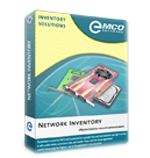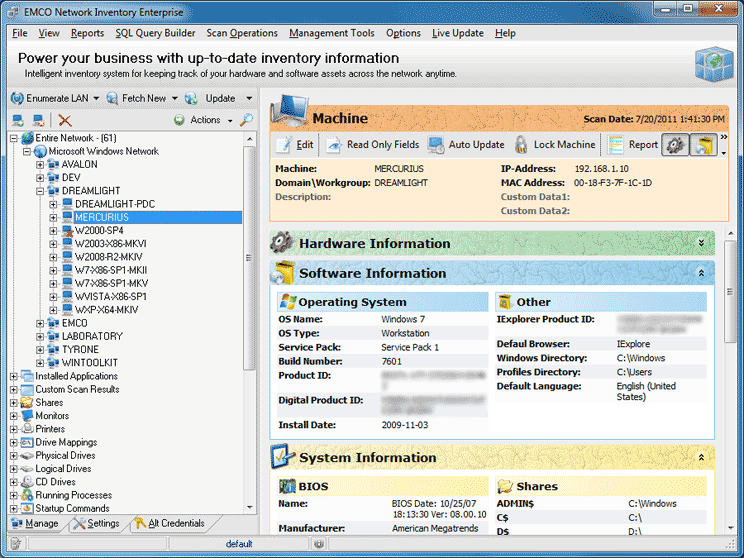
EMCO Network Inventory is a tool capable of automatically gathering up-to-date information about all..
5.8.22| License: Free |
| Released: EMCO Software |
| Request: Windows 2003/XP/Vista/7/8/8.1/10 |
| Last updated: 05-09-2021 |
| OS: Window |
| Version: 5.8.22 |
| Total download: 1753 |
| Capacity: 28,3 MB |
EMCO Network Inventory is a tool that automatically collects up-to-date information about all software and hardware repositories from all remote computers in the network, and then inserts them into an inventory database. . You can then use the data to find the information you need and build a network hardware/software inventory report.
With EMCO Network Inventory, you can get detailed network inventory information in just a few clicks without having to configure your system, deploy login or WMI scripts or install clients on your computer. from afar.

Operating System
Name, type, description, service pack, product ID, serial number, installation date.
System Environment
Default language, Windows Directory, default browser, default email client, Internet Explorer ID, MS Office ID.
Shared Resources
Name, comment, format, path.
System Services
Service name, display name, initialization options, login as account.
Scheduled Task
Task name, next launch date/time, activate/deactivate.
User Accounts
Username, full name, permissions, account type, last login, number of logins, script path, maximum storage, password expiration,...
Program folder
Program folder name.
Network Protocol
Protocol name, description, status, installation date.
Processor
Full processor specs, manufacturer, frequency,…
BIOS
Name, manufacturer, version, serial number.
Circuit board
Full board specifications.
Memory
Total installed memory, remaining memory.
graphics card
Graphic card specifications, resolution.
Screen
Screen specs, manufacturer, model, serial number, production date.
Drive
Drive name, total space, free space, file system,…
CD/DVD drive
Drive name, manufacturer, caption, description,…
Printers
Printer name, local/network status, port, driver, shared/unshared status.
Installed Apps
App name, version, publisher, install date, install path, uninstall command.
Aggregate installed applications
Information from all scanned computers on the local network will be grouped into a dedicated viewer to display the list of installed applications on the network and the total number of installed packages of each app.
Track license changes
Changes in the list of installed applications will be automatically monitored and reported to display a list of recently installed and uninstalled applications on the network computer.
p>
Filter apps
Software reports can be filtered to exclude those that comply with a predefined application name mask.
Application Pool
By default, aggregate reports can group software items by application name. Some items will be considered similar applications if they have exactly the same name. This can be changed by defining custom application name masks to group items with different names and display them in the report as one item.
Remote registry and file system scanning
Registry and file systems on selected remote computers can be scanned for all files, folders, registry keys and values according to the specified criteria.
Automatic processing
Remote hardware/software repositories can be launched in automatic mode to update information after a set period of time. Collected data can be used to automatically generate a report in print form.
Customize scan criteria
Can scan the remote computer for the existence of certain files, services or registry keys.
Data Protection
Any application parameter can be preserved from unwanted changes if it is manually marked as read-only. In this case, it will not be affected after repeated scans.
Lock your computer
All app store information from a certain computer can be marked as read-only if the computer is locked.
Export displayed data
Appstore information is displayed in a variety of formats, and dialog boxes can be quickly exported with a single click. The following formats can be exported: MS Excel, MS Word, MS Access, PDF, CSV, Text, XML, Clipboard,,…
Detailed report for one or more computers
Appstore reports can be prepared from a specific computer, all computers in a network, or a group of computers defined by an IP range. The information in the report can be selected from a list of available applications.
Save reports in multiple formats
The report can be exported to PDF, RTF, HTML, Text, JPEG format.
Customize report name
The name of the report can be changed to include company name, logo, author information, etc.
Customize Report
In addition to the preset report set, the program allows to create new custom reports.
To prepare for appstore crawling, simply do the following. Firstly, you need to have admin rights to access the remote computer. If the current account does not have admin rights, you need to go to tab Alt Credentials and set the information there. Second, you need to go to the Settings tab and check what data will be collected from the remote computer. Note that some data is collected through Windows Management Instrumentation (WMI), so this service should be enabled on the remote computer.
Collecting will be activated by the Enumerate LAN button located on the management toolbar. This button will launch the network enumeration to identify computers in all domains and workgroups within the local network. Warehouse information will be extracted from all remote computers and saved to a local database. If you want to reduce the number of computers that will scan, you can choose another option such as scanning by IP range from the Enumerate LAN menu that appears.
After scanning, Machine Tree displays the computers found and grouped by domain and workgroup. You can browse to see app store information. From there, you can view asset information for a workgroup/domain or a computer or certain computer components,…
When performing the first scan, Machine Tree will be filled with collected data. The next time you need to create an application store, you can choose to collect information from new computers in the network, or update information on existing computers in the tree. In this case, you need to use the Fetch New or Update button on the management toolbar. If the Enumerate LAN button is pressed, the network will scan and the data collection process is repeated and your existing data will be replaced with new data.
When the repository crawl is complete, you can browse it by selecting the required nodes in the Machines Tree. This way, you can get inventory information for each specific computer or overview for each asset on the network. But if there are hundreds or thousands of computers in the network, it will be difficult to find the necessary information.
EMCO Network Inventory can help you easily manage and narrow down information by applying filters. For example, identify computers that have problems related to low memory. To search for them, select the domain or workgroup on the Networking node in the tree. Summary information about computers in the domain or workgroup will be displayed on the right. This information includes the Physical Mem field so a filter using this field can be applied to show only computers with problems. Click the button below on the field name and in the menu that appears to select the item (Custom...).
After applying the filter, the displayed data will be updated to show only computers that comply with the filter condition. Note that you can apply multiple filters at once, for example to identify computers with Windows Vista or low memory.
5
4
3
2
1